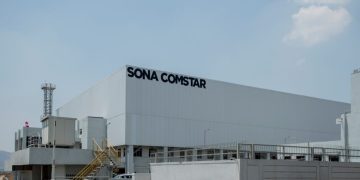Due to more and more electric vehicles hitting the road, the number of plastic parts also growing in carbody. Plastics made their grand debut in automotive bumpers with the 1973 Corvette. Nearly 50 years later, they’re still going strong and making further inroads, replacing metal components all over the vehicle. Who would have thought in 1973 that intake manifolds would eventually be made of plastic?
You’ve probably heard that electric cars are coming. They’re going to have even more plastic parts to reduce weight and cost, and it’s especially important on electric cars because the lighter the weight, the greater the range.
As an example, the Aptera electric car weighs 800 kg versus the Mini E at 1440 kg. With the same 35kWH battery on the Mini, the Aptera will go 563 kms and the Mini will only go 177 kms. That’s a 133% improvement in range for a 43% reduction in weight. Admittedly, aerodynamics also has a large influence – the Aptera looks like an alien pod whereas the Mini looks like an actual car with room for four. But weight is a huge influence because it takes energy to accelerate that additional mass every time the light turns Green.
The bottom line is that plastics aren’t going away, and if you repair collision-damaged vehicles, you’re going to have several – if not dozens of – damaged plastic parts on each vehicle you repair.
Repair vs. Replace
The first question is, should you repair the damaged part or replace it? Cosider the following safety-related queries before you decide on it.
Research the OEM repair procedures. If repair of the part is prohibited by the OEM, then replace the part.
Is the damaged area over a radar sensor, like a blind spot monitor or cross-traffic sensor? If so, replace the part.
Is the part structural, like a bumper beam? Can the part affect airbag deployment, like interior trim over an airbag? If either answer is yes, then replace the part.
If the answers to each of these three safety-related questions is no, then you need to decide whether repairing the damaged plastic part will create a better outcome for the shop, the technician and the vehicle owner. For this question, there are several points to consider:
Cost: If the replacement part is cheap, just replace it. You have bigger battles to fight. However, as the replacement cost increases, so does the incentive to repair it. To take an extreme– but not uncommon – example, many headlights today are well into four figures. If the light functions properly and only has a broken tab, repairing the tab can be more profitable for the shop and will save the vehicle owner or insurer money.
Time: Cars sitting there waiting for parts are no good for anybody. Part shortages are more common than ever in these times. You can accelerate your cycle time by repairing parts that are on back order. You may even be able to charge a premium if you can get the vehicle back to its owner and out of a rental sooner.
Skills: The part might be repairable, but are your technicians up to the task? Can your repair planners identify when a part is repairable? If not, get your staff some training from AKEMI India or one of their distributor partners.
Tools and Equipment: If your technicians have the skills to repair plastics but don’t have the necessary equipment to do the job, you’re handicapping yourself. Most repairs can be done with adhesives, but if there’s a hole poked into a washer bottle, you’ll need a welder for that. Make the necessary investments in your capabilities so you can take advantage of the repair opportunities that are sure to arise.
Environment: Since there’s no nationwide company picking up scrap plastic bumpers anymore and no financial incentive to collect them, millions of them are going to and clogging up landfills every year. You have the power to decide whether each damaged part is sent to the landfill or not.
Assuming you decide that repairing the part is going to create a better overall outcome and that your technicians have the tools and skills to do the job, let’s go over the different technologies involved with plastics and their repair.
Polypropylene is King
Roughly 98% of late-model bumper covers are molded of polypropylene (PP/TPO) blends. Why? They’re cheap! The average cost of TPO resin is about 192/- per kg, so that’s 960/- of material cost for an average bumper cover. That’s roughly half the cost of alternative plastics such as urethane or polycarbonate.
Polypropylene also dominates in the realm of headlight housings, textured trim, underbody fairings and under-hood plastics. If the part is black and waxy looking on the backside, most likely it’s a PP/TPO blend.
Look for the symbols “PP,” “PP+EPM” or “TEO” on the backside.
Under the hood, the closer the part gets to the engine or other hot components, the more likely it’s going to be made of nylon (PA). This is the engineering thermoplastic with the highest melting point. You’ll also see many nylons and polypropylenes with glass fiber reinforcement–look for PA+GF or PP+GF. The “GF” stands for glass fiber, and the number after it gives the approximate weight percentage of glass fiber in the alloy.
Polyethylene is also widely used under the hood. Look for “PE” on washer bottles, overflow bottles and inner fender liners. Adhesives won’t stick to polyethylene, so you’ll need a welder to do repairs on these parts.
Two-Part Repair Materials
Identification of the plastic is not strictly required for many two-part repair materials. Depending on the brand, they will often stick to PP/TPO plastics without the need for adhesion promoters and can thus be used on a variety of plastics.
The process of applying two-part materials is roughly the same. Adhesives don’t stick well to glossy surfaces, so you have to clean and sand the plastic first. Always clean the plastic before sanding it; this keeps you from grinding contaminants under the surface. It’s a good idea to clean the plastic first with soap and water. After drying, use a plastic cleaning solution to remove silicones and mold release agents from it. Then, sand the plastic at low speed with 80 to 180 grit paper to put a good “tooth” on the surface.
Always follow the directions for the specific product you’re using. On PP/TPO blends, most adhesives will require the use of an adhesion promoter first. This coating wets out on the plastic and, when dry, the remaining resin will allow the adhesive to wet out on it. The product “modifies” the surface tension of the plastic, allowing the adhesive to wet out on it better.
Many two-parts will recommend that a fiberglass-reinforcing mesh be embedded into the patch applied to the backside of the repair area. Most of the time, this is achieved by applying a thin coating of adhesive to the plastic first, then embedding the mesh and finally coating once again with another layer of adhesive. In this way, the mesh serves the same function as rebar in concrete.
Usually, you’ll put a patch of repair material on the backside of the damaged area first to stabilise it, then V-groove the front side and apply more adhesive into the V-groove using the same surface prep procedures. Some adhesive systems require the use of a finishing filler for the final cosmetic surface. Every system has different requirements, so it’s imperative that you follow your specific product’s directions.
Airless Plastic Welding
The most recent innovation in plastic repair is airless welding. The main advantage to airless welding is speed. It’s faster than two-part repairs because there’s no need to wait for the material to cure. The welding rod is a thermoplastic material, so it can be quick-cooled with air or water.
The entire weld can often be done before the adhesion promoter flashes off for a two-part repair. Welding allows the entire repair to be done without walking away, greatly reducing the cycle time.
Strength is another asset: A fusion weld with similar materials is stronger than an adhesive bond. And because the extruded structure of the welding rod is unaffected by the welding process, it retains its original strength. In a airless weld, only the surfaces are melted and fused together. The strong, extruded structure of the rod remains, lending its inherent strength to the repair.
Welding allows for the repair of small areas such as tabs, mounting slots and holes where there’s not enough surface area for two-part adhesives to stick to. The consumable material for welding is much less expensive than two-parts; in fact, the repair material will cost less than just the mixer tip, not to mention the repair material itself. Finally, plastic welding rods have unlimited shelf life.
Airless welds are easy to perform after some training and a little practice. Just as with a two-part repair, the plastic must be cleaned then V-grooved. The foot of the welder is pressed on to the area where the welding rod meets the base material. The shoe melts the lower surface of the rod and the top surface of the substrate; these melted surfaces are fused together with a steady downward pressure on the welding rod. If your technicians need training, check out courses from AKEMI India.
The Next 50 Years
Over the last 50 years, there have been huge changes in every facet of the collision industry. One constant, however, is the presence of plastic parts in vehicles and their ever-expanding use into different areas of the vehicle. In the age of ADAS, battery electric and autonomous vehicles, the use of plastic parts will only continue to expand.
Airless plastic welding and two-part adhesives are established technologies. Most shops do repairs but it’s rare to find a shop that has mastered the process and maximises the potential. If repair is not prohibited by the OEM for safety reasons and if a repair creates a better outcome for all parties, the next question to ask is whether you have the skills and equipment to get the job done. If you don’t, seek help from your suppliers to get the tools and training you need to repair the vehicles you’ll see coming through your doors in the next 50 years.
Author
AMIT ASIJA
National Business Development Head – Automotive Business
AKEMI Technology

























































